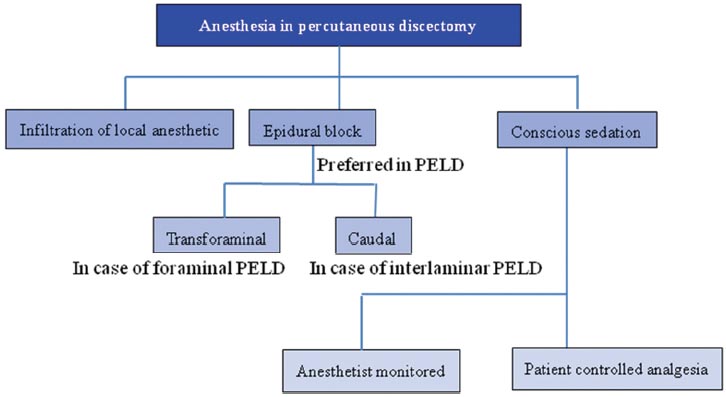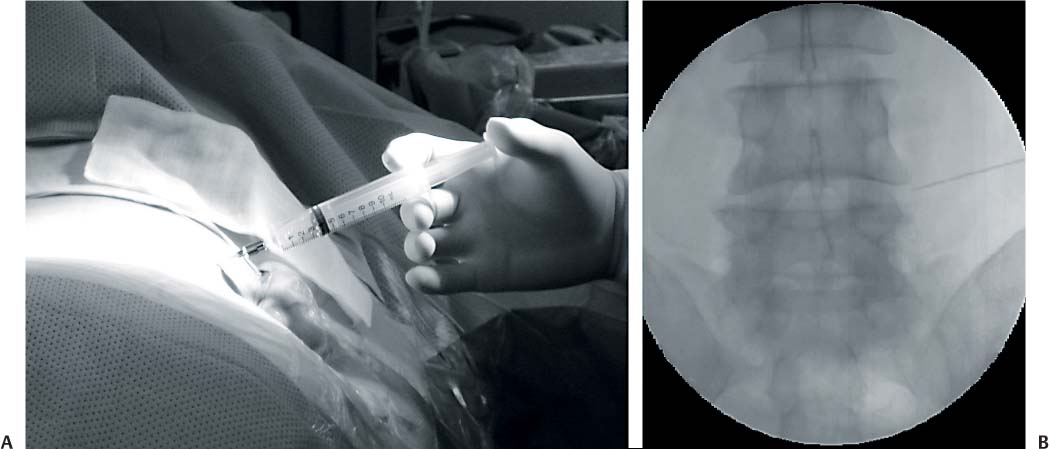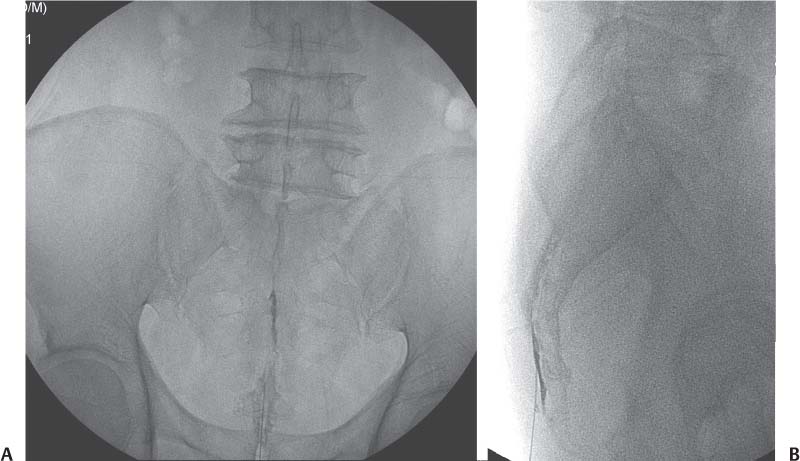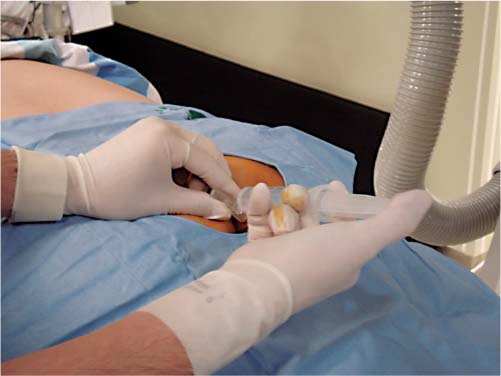5 Anesthesia • Percutaneous endoscopic diskectomy differs from other spinal operations in that it presents particular demands for anesthesiology: — Limited endoscopic field — Poor tactile feedback obtained from long endoscopic tools — Surgery performed at a depth — Less familiar anatomy — Poor three-dimensional spatial orientation • These reasons may increase the chance of iatrogenic neural injury. • The safety of this procedure is amplified if the surgeon is able to assess the functional results intraoperatively by communicating with the patient. • In doubtful situations, the patient’s response in terms of presence of pain and movement of toes or fingers can help the surgeon to confirm and avoid injury to the neural structures. • Elderly patients, who are usually associated with medical problems (e.g., diabetes, hypertension, and cardiac diseases), better tolerate percutaneous procedures, both intraoperatively and postoperatively, because they can be performed under local anesthesia. • It is possible to perform these procedures under local anesthesia because the actual tissue dissection is very limited. • The procedure is based on the principle of sequential dilatation of the soft tissues. • The only significant pain generators during the procedure are the skin and annulus. • This pain and discomfort can be well negated with infiltration of local anesthetics, epidural block, and conscious sedation (Fig. 5.1). • The preferred choice as a local anesthetic is 1% lido-caine, with its quick onset and a duration of 1 to 1.5 hours, which is adequate for the procedure. • The lower concentration (1% lidocaine) is used instead of 2% because the drug in lower concentrations partially blocks the sensory nerve fibers without impairing the motor responses. • After infiltrating the skin with 1 to 2 mL of lidocaine and waiting for 1 minute, a 20-gauge thin spinal needle 5 to 7 inches in length is used to infiltrate the intermuscular planes with 5 to 10 mL of lidocaine along the intended trajectory up to the facet joint (Fig. 5.2). • The 18 g approach needle is then inserted under fluoroscopic guidance until it reaches the epidural space just outside the annulus. • At this point the needle tip corresponds to the medial or midpedicular line in the anteroposterior view and the posterior vertebral line in the lateral view of fluoroscopy. • Lidocaine (3 to 4 mL) is injected in the epidural space just before puncturing the annulus. • There is a sudden release of resistance during injection of the drug if the needle is in the epidural space. • The space can also be confirmed by injecting a radiopaque dye to rule out intrathecal leakage (Fig. 5.3). • This serves as a transforaminal epidural block. • The injected local anesthetic solution produces anal-gesia by blocking conduction at the intradural spinal nerve roots. • Another 1 to 2 mL is infiltrated on the outer surface of the annulus. • For an interlaminar approach we prefer a caudal epidural block given prior to the beginning of the operation for two reasons (Fig. 5.4). — A caudal block given prior to the operation provides sufficient time to achieve pain relief before the insertion of the sequential dilators and the working cannula, which is a very painful procedure. — The irrigation fluid from the endoscope inserted through the epidural space immediately following an epidural injection washes out the drug before it starts taking effect, without causing sufficient analgesia. • An additional infiltration of the outer surface of the annulus provides adequate pain relief during the procedure. • Conscious sedation is a medically controlled state of depressed consciousness that allows protective reflexes to be maintained while retaining the patient’s ability to keep the airway patent independently and continuously and permitting appropriate responses to physical stimulation and verbal commands.1–3 Fig. 5.1 Use of different types of anesthesia in percutaneous endoscopic lumbar diskectomy (PELD). • A combination of a sedative and an opioid analgesic is most commonly used for this purpose. • Anxiety and procedure-related pain are the two major reasons for the use of sedatives. • Midazolam is used in combination with either remifentanil or fentanyl or propofol or the combination of remifentanil and propofol. • Conscious sedation begins in the ward when the patient is administered 3 mg of midazolam (0.05 mg/kg) intramuscularly by the ward nurse 1 hour before the surgery. • In the operating room, after the patient is placed in the prone position, the anesthetist may repeat half the initial dose of midazolam intravenously (IV) if the patient is not feeling sleepy. Fig. 5.2 (A,B) Infiltration of skin and intermuscular planes with lidocaine. Fig. 5.3 (A,B) C-arm pictures showing leakage of the dye. • Continuous blood pressure, oxygen saturation, and echocardiographic monitoring is mandatory during conscious sedation. • Supplemental oxygen is administered with a Venturi mask. • We prefer remifentanil as the additional drug because of its very short duration of action (3 to 4 minutes), which is independent of the dose and duration of use.4 — It is started as a continuous infusion with an infusion pump at a dose of 1 μg/kg/min. — The dose is decreased to 0.5 μg/kg/min after the most painful part of the procedure (i.e., after the insertion of the working sleeve through the annulus). — The dose may be increased at times of increased pain. • The common side effects of remifentanil are respiratory depression, pruritis, and difficulty in voiding, especially in the elderly. • The infusion should be stopped immediately if there is a drop in the oxygen saturation. • Remifentanil does not have an analgesic effect, which makes it easier for the surgeon to assess the success of surgery by performing the straight leg raising test immediately after the operation. • If fentanyl is used, it is administered as a bolus dose of 50 μg (0.8 μg/kg) before the beginning of the operation. — The peak effect of action is usually 8 minutes. — The dose can be repeated 3 to 5 minutes before insertion of the obturator in the annulus or if there is continuing pain during the procedure to a total dose of 150 μg. • Propofol, if used, should be administered as a continuous infusion with the help of target-controlled infusion (TCI) pumps, which control accurate delivery of the drug and ensure careful monitoring. • Short-acting agents are preferred to long-acting ones. • Continuous infusions as opposed to bolus injections provide an equivalent level of sedation with a smaller total drug dose. • An analgesic agent is valuable during anticipated periods of painful stimulation. Fig. 5.4 A caudal epidural block given prior to the beginning of the operation. • Because of the loose arrangement of the deep cervical fascia and the free mobility of the tracheoesophageal complex over the vertebral bodies, there is a natural plane between the tracheoesophageal complex on the medial side and the common carotid sheath on the lateral side. • Moderate pressure applied with the fingers in an effort to separate these structures pushes the skin close to the disk, making it possible to palpate the cervical spine. • For this reason infiltration of the superficial skin with 2 to 3 mL of lidocaine suffices for the insertion of the working cannula. • The outer surface of the annulus is also infiltrated to allow pain-free insertion of the obturator into the disk space. • Epidural block is not given during cervical diskectomy because the approach is from the anterior side (Fig. 5.5). • Conscious sedation is achieved in essentially the same way as that used during percutaneous endoscopic lumbar diskectomy. • Some surgeons prefer general anesthesia for cervical diskectomy especially if the patient is anxious.
Infiltration and Epidural Anesthesia in Percutaneous Endoscopic Lumbar Diskectomy
Transforaminal Approach
Interlaminar Approach
Conscious Sedation
Conscious Sedation in Percutaneous Endoscopic Lumbar Diskectomy
Selection of Sedative Agents
Anesthesia in Percutaneous Cervical Diskectomy
Infiltration Anesthesia
Conscious Sedation
Stay updated, free articles. Join our Telegram channel

Full access? Get Clinical Tree






